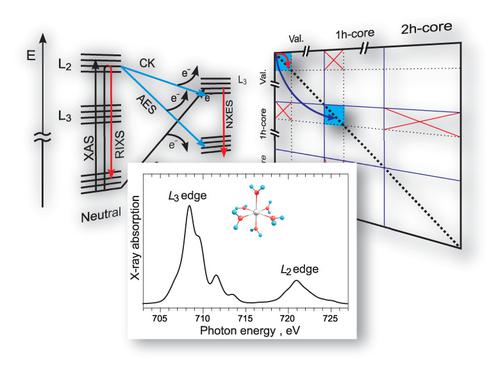当前位置:
X-MOL 学术
›
WIREs Comput. Mol. Sci.
›
论文详情
Our official English website, www.x-mol.net, welcomes your feedback! (Note: you will need to create a separate account there.)
Theoretical X‐ray spectroscopy of transition metal compounds
Wiley Interdisciplinary Reviews: Computational Molecular Science ( IF 11.4 ) Pub Date : 2019-07-24 , DOI: 10.1002/wcms.1433 Sergey I. Bokarev 1 , Oliver Kühn 1
Wiley Interdisciplinary Reviews: Computational Molecular Science ( IF 11.4 ) Pub Date : 2019-07-24 , DOI: 10.1002/wcms.1433 Sergey I. Bokarev 1 , Oliver Kühn 1
Affiliation

|
X‐ray spectroscopy is one of the most powerful tools to access structure and properties of matter in different states of aggregation as it allows to trace atomic and molecular energy levels in course of various physical and chemical processes. X‐ray spectroscopic techniques probe the local electronic structure of a particular atom in its environment, in contrast to ultraviolet/visible (UV/Vis) spectroscopy, where transitions generally occur between delocalized molecular orbitals. Complementary information is provided by using a combination of different absorption, emission, scattering as well as photo‐ and autoionization X‐ray methods. However, interpretation of the complex experimental spectra and verification of experimental hypotheses is a nontrivial task and powerful first principles theoretical approaches that allow for a systematic investigation of a broad class of systems are needed. Focusing on transition metal compounds, L‐edge spectra are of particular relevance as they probe the frontier d‐orbitals involved in metal–ligand bonding. Here, near‐degeneracy effects in combination with spin‐orbit coupling lead to a complicated multiplet energy level structure, which poses a serious challenge to quantum chemical methods. Multiconfigurational self‐consistent field (MCSCF) theory has been shown to be capable of providing a rather detailed understanding of experimental X‐ray spectroscopy. However, it cannot be considered as a “blackbox” tool and its application requires not only a command of formal theoretical aspects, but also a broad knowledge of already existing applications. Both aspects are covered in this overview.
中文翻译:

过渡金属化合物的理论X射线光谱
X射线光谱学是访问处于不同聚集状态的物质结构和性质的最强大工具之一,因为它可以跟踪各种物理和化学过程中的原子和分子能级。X射线光谱技术探测特定原子在其环境中的局部电子结构,这与紫外/可见(UV / Vis)光谱相反,后者通常发生在离域分子轨道之间的跃迁。通过结合使用不同的吸收,发射,散射以及光和电离X射线方法来提供补充信息。然而,解释复杂的实验光谱和验证实验假设是一项艰巨的任务,需要强有力的第一原理理论方法,需要对广泛类别的系统进行系统研究。专注于过渡金属化合物,L边缘光谱特别重要,因为它们探测了涉及金属-配体键合的前沿d轨道。在这里,近简简效应与自旋轨道耦合相结合,导致了复杂的多重能级结构,这对量子化学方法提出了严峻的挑战。多配置自洽场(MCSCF)理论已被证明能够提供对实验X射线光谱学的相当详细的了解。但是,它不能被视为“黑匣子”工具,其应用不仅需要形式理论方面的命令,而且还需要对已经存在的应用程序有广泛的了解。本概述涵盖了这两个方面。
更新日期:2019-11-18
中文翻译:

过渡金属化合物的理论X射线光谱
X射线光谱学是访问处于不同聚集状态的物质结构和性质的最强大工具之一,因为它可以跟踪各种物理和化学过程中的原子和分子能级。X射线光谱技术探测特定原子在其环境中的局部电子结构,这与紫外/可见(UV / Vis)光谱相反,后者通常发生在离域分子轨道之间的跃迁。通过结合使用不同的吸收,发射,散射以及光和电离X射线方法来提供补充信息。然而,解释复杂的实验光谱和验证实验假设是一项艰巨的任务,需要强有力的第一原理理论方法,需要对广泛类别的系统进行系统研究。专注于过渡金属化合物,L边缘光谱特别重要,因为它们探测了涉及金属-配体键合的前沿d轨道。在这里,近简简效应与自旋轨道耦合相结合,导致了复杂的多重能级结构,这对量子化学方法提出了严峻的挑战。多配置自洽场(MCSCF)理论已被证明能够提供对实验X射线光谱学的相当详细的了解。但是,它不能被视为“黑匣子”工具,其应用不仅需要形式理论方面的命令,而且还需要对已经存在的应用程序有广泛的了解。本概述涵盖了这两个方面。


























 京公网安备 11010802027423号
京公网安备 11010802027423号